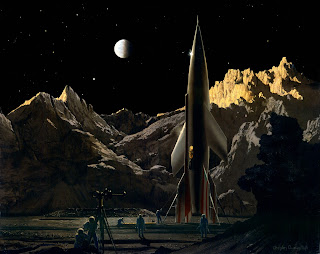“Tell me, Muse, of the man of many ways, who was driven
on far journeys ...
Many were they whose cities he saw, whose minds he learned of,
many the pains he suffered in his spirit on the wide sea,
struggling for his own life and the homecoming of his companions.”
(The Odyssey, Book One, Lines 1-5)
on far journeys ...
Many were they whose cities he saw, whose minds he learned of,
many the pains he suffered in his spirit on the wide sea,
struggling for his own life and the homecoming of his companions.”
I could readily sympathize with any reader
who, encountering The Skylark of Space for the first time and having dutifully read
along as far as chapter 9, might by now be wondering “just where is all this
much vaunted Super Science I’ve been hearing so much about? Other than a flying
bathtub in the first paragraph of the novel, I certainly haven’t seen it yet!”
Well, with the very next chapter, all that is about to change. In fact, it all
changes between lines…
For several chapters, the story is
basically all about burglary and industrial espionage, and in the space of a
few lines on page 48 (of the 1958 revision, page 96 of the F.F.F. edition), we
are in a brand new world.
“A few nights later, in inky blackness, a
huge shape descended rapidly in front of the shed, whose ponderous doors opened
to receive it and closed quickly after it. The Skylark moved lightly and easily
as a wafted feather, betraying its thousands of tons of weight only by the hole
it made in the hard-beaten earth of the floor as it settled to rest. Opening
one of the heavy steel doors, Seaton and Crane sprang out into the darkness. … “She flies!” [Seaton] cried exultantly. She
flies, dearest, like a ray of light for speed and a bit of thistle-down for
lightness. We have been around the moon!”
Around
the Moon! And in the very first trial flight of the spacecraft!?! We of the
21st Century should not be too scandalized. Such things were common in mid 20th
Century fiction. Allow me to restrict myself to movies alone. Let’s take a look
at how they viewed the possibilities of the first-ever voyage into space:
Destination
Moon (1950) – First manned spaceflight, straight to the
Moon.
Rocketship
X-M (1950) – First manned spaceflight, straight to the
Moon (which went off course and landed on Mars instead!)
Flight
to Mars (1951) – First Manned spaceflight,
straight to Mars.
Radar
Men from the Moon (1952) – First manned spaceflight,
straight to the Moon.
Cat
Women on the Moon (1953) – First manned spaceflight,
straight to the Moon.
Missile to the Moon
(1958) – First manned spaceflight, straight to the Moon.
Angry
Red Planet (1959) – First manned spaceflight,
straight to Mars.
12 to the Moon (1960) – First manned spaceflight, straight to the Moon.
12 to the Moon (1960) – First manned spaceflight, straight to the Moon.
And this* was followed, of course, by Yuri
Gagarin, Alan Shepard, and the rest of historical reality - with no less than 6 Mercury missions, 12 Gemini, and 4 Apollo
flights (not to mention the numerous unmanned Ranger, Surveyor, and Lunar
Orbiter probes) before Neil Armstrong made that “one small step” onto the lunar
surface.
I strongly suspect that much of the reason
for the failure of imagination on the part of these early pioneers of
imaginative fiction was in the very word “destination”, as in the first movie
title listed above. It was hard for them to wrap their minds around the idea of
empty space (a.k.a., in orbit) being a destination. Some solid surface to land
on was required for that.
In any event, despite such a stupendous
initial flight, Smith was not about to hang around the solar system for an
instant longer than he had to. He is off to the stars! Believe it or not, this
was uncharted territory for science fiction when Skylark was being
written. In the end, the novel shared the palm for “first extra-solar
adventure” with Edmond Hamilton’s first Interstellar Patrol adventure “Crashing Suns”, which was published in the very same month (August
1928) by the magazine Weird Tales. (So something was
undoubtedly in the water that year!) Prior to that “august” month,
extraterrestrial voyages had been restricted to worlds within our solar system.
But ever after, it was “Sic itur ad atsra.” (The Aeneid, Book IX, Line
641)
*
A
notable exception to this catalogue is the 1950 film Project Moonbase.
Finally, a movie that has even a distant resemblance to reality. Initial
flights into orbit, followed by the building of a space station, and then and
only then an attempt to fly out to the Moon – and even then, only a flyby
mission (around the Far Side and back).






No comments:
Post a Comment